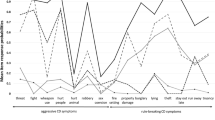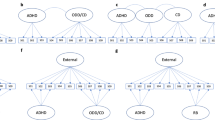Abstract
Many studies have examined the correlates and factor structure of the conduct disorder (CD) criteria in child and adolescent samples, finding that the set of behaviors defining CD are heterogeneous in nature. However, the factor structure of the CD criteria has not been examined in adults, even though the CD criteria often must be assessed retrospectively when diagnosing antisocial personality disorder (ASPD) in adulthood. To advance understanding of assessing CD behaviors retrospectively in adults, we present factor analytic and correlational results from a large sample of adult outpatients (N = 1793). Our results indicate that CD ratings are defined by at least two latent factors of Rule Violation (e.g., curfew violations) and Aggression (e.g., using a weapon). Ratings of aggressive behaviors tended to show somewhat stronger associations with other externalizing psychopathology than did rule violation ratings. Furthermore, CD dimensions identified in our factor analyses correlated robustly with ASPD but correlated just as strongly with diagnostic ratings of other externalizing psychopathology such as substance use history. We discuss how these findings from a large adult sample parallel results from child and adolescent samples indicating that the CD criteria are defined by distinct dimensions. Furthermore, we interpret these findings within the context of other recent studies suggesting that a CD history may not be a specific precursor to ASPD in adulthood.
Similar content being viewed by others
References
American Psychiatric Association. (2013). Diagnostic and statistical manual of mental disorders (5th ed.). Washington, DC: Author.
Burt, S. A. (2009). Are there meaningful etiological differences within antisocial behavior? Results of a meta-analysis. Clinical Psychology Review, 29, 163–178.
Castellanos-Ryan, N., & Conrod, P. J. (2011). Personality correlates of the common and unique variance across conduct disorder and substance misuse symptoms in adolescence. Journal of Abnormal Child Psychology, 39, 563–576.
Clark, L. A., & Watson, D. (2019). Constructing validity: New developments in creating objective measuring instruments. Psychological Assessment. Advance online publication.
Endicott, J., & Spitzer, R. L. (1978). A diagnostic interview: The schedule for affective disorders and schizophrenia. Archives of General Psychiatry, 35, 837–844.
First, M. B., Spitzer, R. L., Gibbon, M., & Williams, J. B. W. (1995). Structured Clinical Interview for DSM-IV Axis I Disorders — Patient Edition (SCID-I/P, version 2.0). New York, NY: Department of Biometrics Research, New York state psychiatric institute.
Gelhorn, H., Hartman, C., Sakai, J., Mikulich-Gilbertson, S., Stallings, M., Young, S., Rhee, S., Corley, R., Hewitt, J., Hopfer, C., & Crowley, T. (2009). An item response theory analysis of DSM-IV conduct disorder. Journal of the American Academy of Child & Adolescent Psychiatry, 48, 42–50.
Gorlin, E. I., Dalrymple, K., Chelminski, I., & Zimmerman, M. (2016). Diagnostic profiles of adult psychiatric outpatients with and without attention deficit hyperactivity disorder. Comprehensive Psychiatry, 70, 90–97.
Hopwood, C. J., & Donnellan, M. B. (2010). How should the internal structure of personality inventories be evaluated? Personality and Social Psychology Review, 14, 332–346.
Hu, L., & Bentler, P. M. (1999). Cutoff criteria for fit indexes in covariance structure analysis: Conventional criteria versus new alternatives. Structural Equation Modeling, 6, 1–55.
Hyde, L. W., Burt, S. A., Shaw, D. S., Donnellan, M. B., & Forbes, E. E. (2015). Early starting, aggressive, and/or callous–unemotional? Examining the overlap and predictive utility of antisocial behavior subtypes. Journal of Abnormal Psychology, 124, 329–342.
Kotov, R., Krueger, R. F., Watson, D., Achenbach, T. M., Althoff, R. R., Bagby, R. M., Brown, T. A., Carpenter, W. T., Caspi, A., Clark, L. A., Eaton, N. R., Forbes, M. K., Forbush, K. T., Goldberg, D., Hasin, D., Hyman, S. E., Ivanova, M. Y., Lynam, D. R., Markon, K., Miller, J. D., Moffitt, T. E., Morey, L. C., Mullins-Sweatt, S. N., Ormel, J., Patrick, C. J., Regier, D. A., Rescorla, L., Ruggero, C. J., Samuel, D. B., Sellbom, M., Simms, L. J., Skodol, A. E., Slade, T., South, S. C., Tackett, J. L., Waldman, I. D., Waszczuk, M. A., Widiger, T. A., Wright, A. G. C., & Zimmerman, M. (2017). The hierarchical taxonomy of psychopathology (HiTOP): A dimensional alternative to traditional nosologies. Journal of Abnormal Psychology, 126, 454–477.
Lahey, B. B., & Waldman, I. D. (2012). Phenotypic and causal structure of conduct disorder in the broader context of prevalent forms of psychopathology. Journal of Child Psychology and Psychiatry, 53, 536–557.
McGonigal, P., Kerr, S., Morgan, T. A., Dalrymple, K., Chelminski, I., & Zimmerman, M. (2019). Should childhood conduct disorder be necessary to diagnose antisocial personality disorder in adults? Annals of Clinical Psychiatry, 31, 36–44.
Pfohl, B., Blum, N., & Zimmerman, M. (1997). Structured interview for DSM-IV personality. Washington, DC: American Psychiatric Press.
Robinson, M. D., & Clore, G. L. (2002). Belief and feeling: Evidence for an accessibility model of emotional self-report. Psychological Bulletin, 128, 934–960.
Salekin, R. T. (2016). Psychopathy in childhood: Why should we care about grandiose–manipulative and daring–impulsive traits? British Journal of Psychiatry, 209, 189–191.
Salekin, R. T. (2017). What do we know about psychopathic traits in children? Journal of Child Psychology and Psychiatry, 58, 1180–1200.
Somma, A., Krueger, R. F., Markon, K. E., & Fossati, A. (2019). The replicability of the personality inventory for DSM–5 domain scale factor structure in U.S. and non-U.S. samples: A quantitative review of the published literature. Psychological Assessment, 31, 861–877.
Stanton, K., McDonnell, C. G., Hayden, E. P., & Watson, D. (2020). Transdiagnostic approaches to psychopathology measurement: Recommendations for measure selection, data analysis, and participant recruitment. Journal of Abnormal Psychology, 129, 21–28.
Stanton, K., & Zimmerman, M. (2018). Unique and shared features of narcissistic and antisocial personality disorders: Implications for assessing and modeling externalizing traits. Journal of Clinical Psychology, 75, 433–444.
Tackett, J. L., Krueger, R. F., Iacono, W. G., & McGue, M. (2005). Symptom-based subfactors of DSM-defined conduct disorder: Evidence for etiologic distinctions. Journal of Abnormal Psychology, 114, 483–487.
Tackett, J. L., Krueger, R. F., Sawyer, M. G., & Graetz, B. W. (2003). Subfactors of DSM-IV conduct disorder: Evidence and connections with syndromes from the child behavior checklist. Journal of Abnormal Child Psychology, 31, 647–654.
Watson, D. (2004). Stability versus change, dependability versus error: Issues in the assessment of personality over time. Journal of Research in Personality, 38, 319–350.
Wothke, W. (1993). Nonpositive definite matrices in structural modeling. In K. A. Bollen & J. S. Long (Eds.), Testing structural equation models (pp. 256–293). Newbury Park, CA: Sage.
Yu, C. Y. (2002). Evaluating cutoff criteria of model fit indices for latent variable models with binary and continuous outcomes. UCLA: Doctoral dissertation.
Zimmerman, M. (2016). A review of 20 years of research on overdiagnosis and underdiagnosis in the Rhode Island methods to improve diagnostic assessment and services (MIDAS) project. The Canadian Journal of Psychiatry, 61, 71–79.
Author information
Authors and Affiliations
Corresponding author
Ethics declarations
Compliance with Ethical Standards and Conflict of Interest
The authors have no conflicts of interest to report, and there is no funding to report for this research.
Ethical Approval
This research received approval from the authors’ relevant institutional review board. All procedures performed in studies involving human participants were in accordance with the ethical standards of the institutional and/or national research committee and with the 1964 Helsinki declaration and its later amendments or comparable ethical standards.
Informed Consent
Informed consent was obtained from all individual participants included in the study.
Informed Consent and Ethical Standards
Informed consent was obtained from all individual participants included in this study, and this research received approval from the Lifespan - Rhode Island Hospital Institutional Review Board. All procedures performed in studies involving human participants were in accordance with the ethical standards of the institutional and/or national research committee and with the 1964 Helsinki declaration and its later amendments or comparable ethical standards.
Additional information
Publisher’s Note
Springer Nature remains neutral with regard to jurisdictional claims in published maps and institutional affiliations.
Rights and permissions
About this article
Cite this article
Stanton, K., McGonigal, P.T., Kerr, S. et al. Adult Retrospective Reports of Externalizing Behavior: Distinct Dimensions and Key Associations for Past Conduct Disorder Ratings. J Psychopathol Behav Assess 43, 1–11 (2021). https://doi.org/10.1007/s10862-020-09815-6
Published:
Issue Date:
DOI: https://doi.org/10.1007/s10862-020-09815-6




